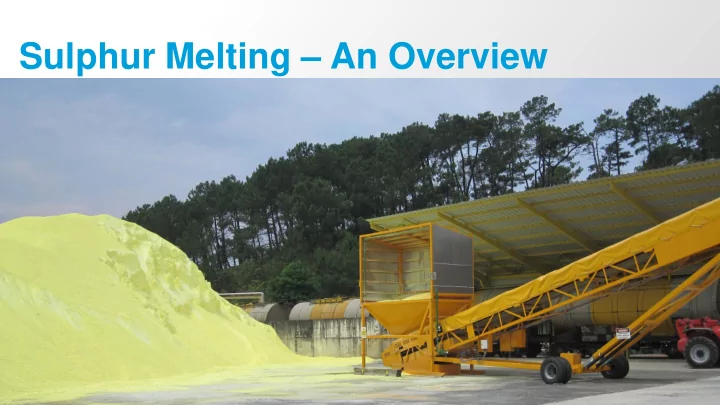

Sulphur Melting – An Overview 1
SANDVIK PROCESS SYSTEMS THE INDUSTRIAL PROCESSING COMPANY
Agenda Sulphur Melting Strategy Before You Melt Sulphur Melting Technologies Footprint Comparison Sulphur Contamination Sulphuric Acid Material Selection Melt Rate Sulphur Block Reclaim 3
Sulphur Melting Strategy Why does sulphur need to be melted? Consumer requires liquid sulphur as a feed stock Examples: Sulphuric acid plant, fertilizer plant Sulphur needs to be converted to a marketable form Examples: Processing a sulphur block, cleanup of leak from liquid system or spillage from conveying system 4
Before You Melt Desired capacity Solid sulphur feed stock specifications Liquid sulphur specifications Operator considerations Emissions considerations Site and footprint considerations 5
Sulphur Melting Technologies Melter Movement: Stationary vs. Mobile Heat Transfer: Immersion vs. Surface Agitation vs. Stagnant Internal vs. External Feed System: Continuous vs. Batch Emissions Management: Open-top vs. Contained Contaminate Removal: Automatic vs. Manual Construction: In-ground vs. Stick-built vs. Skid-package 6
Continuous, Immersion, Agitation 7
Immersion Melting – Footprint Comparison Stagnant Batch (Pit) vs. Agitation with Continuous Feed (Skid) • Skid Area X 3 = Sulphur Pit Area • Pit Depth = 3 meters below ground • Skid Platform Height = 3 meters above ground 8
Sulphur Contamination Solid contaminates Sand, Rocks Carsul Clay Liquid contaminates H 2 O H 2 SO 4 (sulphuric acid) Hydrocarbons, Amines, Glycol Gaseous contaminates H 2 S, SO 2 Sulphur Vapour (Dust) 9
Sulphuric Acid How it happens (2S + 2H 2 O + 3O 2 = 2H 2 SO 4 ) Impact / Neutralization Prevention Keep the sulphur dry! Sodium Lauryl Sulfate (SLS) Strategy SLS / Vancouver Port strategy 10
Material Selection Corrosion Mechanisms Wet Sulphur Corrosion Sulphuric Acid Corrosion Carbon Steel Stainless Steel Cost vs. Benefit 11
Melt Rate Factors to Consider: • Available Surface Area • Particle Size • Ambient Temperature • Moisture 12
Melt Rate – Particle Size Immersion Melting Relationship • Smaller particles = more surface area = higher heat transfer capability • Mass: (1) 100 mm diameter particle = (4000) 6 mm diameter particles = 1.14 kg • Surface Area: (1) 100 mm particle = 0.032 m 2 (4000) 6 mm particles = 0.52 m 2 (16X) 13
Production Capacity Vs. Ambient Temperature (Assuming 130 °C Sulphur Discharge T, 96% Availability) 1600 Capacity (Metric Tonnes/Day) 1400 1200 1000 0% H₂0 1% H₂0 800 2% H₂0 600 3% H₂0 4% H₂0 400 5% H₂0 200 0 -20 -15 -10 -5 0 5 10 15 20 Ambient Temperature, °C 14
Sulphur Block Reclaim Melting needs to be considered in your block pouring strategy because it affects: Size and configuration of block Allowable contamination in block Utility infrastructure Dust control options Availability of block 15
Sulphur Block Reclaim Shah Example: Time required to melt 1.2 million tonnes (4 months production) 1000 TPD, 300 Days Per Year = 4 Years 2000 TPD, 300 Days Per Year = 2 Years 4000 TPD, 300 Days Per Year = 1 Year 16
Questions 17
Recommend
More recommend